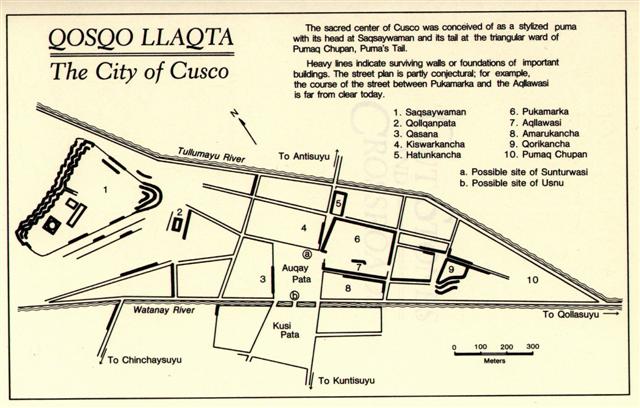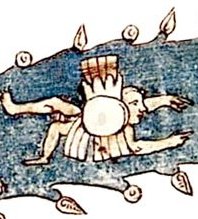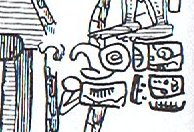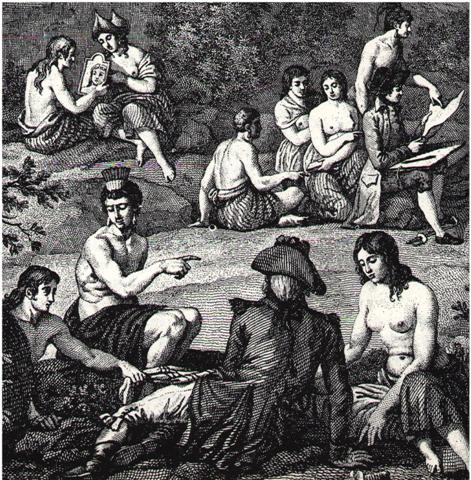41.
The Babylonian Temennu was their 3rd ecliptic
station and nothing was said in this list about Bharani:
|
BABYLONIAN ECLIPTIC CONSTELLATIONS: |
|
0 |
1-iku |
Field measure |
τ
(Anunitum)
Piscium |
16.5 |
April 6 (96) |
|
|
|
1 |
Mahrū-sha-rishu-ku |
Front of the Head of Ku |
β (Sheratan),
γ (Mesarthim) Arietis |
27.4 |
April 17 (107) |
|
2 |
Arku-sha-rishu-ku |
Back of the Head of Ku |
α (Hamal)
Arietis |
30.5 |
April 20 (110) |
|
|
|
3 |
Temennu |
Foundation Stone |
η (Alcyone)
Tauri |
56.1 |
May 16 (136) |
|
4 |
Pidnu-sha-Shame |
Furrow of Heaven |
α (Aldebaran)
Tauri |
68.2 |
May 28 (148) |
Which in a way hardly was
mysterious, because in Babylonian times the
northern spring equinox was not in Aries but in
the Bull.
However, neither did the Arabs list
Bharani. But
her presence was obvious, because the exact
position of 41 Arietis (41.4 as in day 414 = 13
* 29½ + 1) determined the order in
their list up to and including the Mane of the
Lion.
| |
|
Delta |
δ
Andromedae |
8.4 |
3-29
(88) |
- |
- |
| |
|
|
η
Phoenicis |
9.4 |
March 30
(89) |
- |
- |
|
0 |
- |
Zero |
η Andromedae |
11.4 |
April 1 (91) |
- |
0 |
| |
|
Whip |
Cih (γ Cassiopeiai) |
12.4 |
April 2 (92) |
- |
1 |
|
1 |
Al Sharatain |
Pair of Signs |
β Arietis (Sheratan),
γ (Mesarthim) |
27.4 |
April 17 (107) |
16 |
16 |
| |
|
Musca Borealis |
35 (Head of the Fly), 39
(Kaffaljidhma), and
41 Arietis (Bharani) |
41.4 |
May 1 (121) |
14 |
30 |
|
2 |
Al Dabarān |
Follower |
α Tauri (Aldebaran), θ¹, θ²´,
γ (Hyadum I),
δ (Hyadum II), ε (Ain) |
63.4 |
May 23 (143) |
22 |
52 |
| |
|
|
Mintaka (δ Orionis) |
82.4 |
June 11 (162) |
|
71 |
|
3 |
Al Hak'ah |
White Spot |
λ Orionis (Heka),
φ¹, φ² |
83.4 |
June 12 (163) |
20 |
72 |
|
4 |
Al Han'ah |
Brand |
γ Gemini (Alhena), μ (Tejat
Posterior), ν,
η (Tejat Prior),
ξ (Alzirr) |
93.4 |
June 22 (173) |
10 |
82 |
|
5 |
Al Dhirā' |
Forearm |
α Gemini (Castor),
β (Pollux) |
113.4 |
July 12 (193) |
20 |
102 |
|
6 |
Al Nathrah |
Gap |
ε Cancri (Beehive) |
130.4 |
July 29 (210) |
17 |
119 |
|
7 |
Al Tarf |
End |
ξ Cancri,
λ Leonis (Alterf) |
143.4 |
Aug 11 (223) |
13 |
132 |
|
8 |
Al Jabhah |
Forehead |
η Leonis (Al Jabhah),
α (Regulus), ζ (Adhafera), γ
(Algieba) |
152.4 |
Aug 20 (232) |
9 |
141 |
|
9 |
Al Zubrah |
Mane |
δ Leonis (Zosma),
θ (Coxa) |
169.4 |
Sept 6 (249) |
17 |
158 |
|
10 |
Al Sarfah |
Turn |
β Leonis (Denebola) |
178.3 |
Sept 15 (258) |
9 |
167 |
Indeed I therefore used the
fraction 0.4 in order to list stars and glyphs
in a rather perfect parallel order. However,
with Zosma and Coxa there
came a
dramatic change:
... In other
words, the Lion (Sun King) met with his destiny after
the summer solstice, he lost his feet and became like a
woman
|
JULY 2 |
3 (184) |
4 (*105) |
 |
 |
 |
|
Ga4-20 |
Ga4-21 (104) |
Ga4-22 |
|
χ Leonis, χ¹ & χ²
Hydrae |
AL SHARAS (The Rib) |
ZOSMA (Girdle) & COXA (Hips) |
He was
transformed into a liquid state between the
stars δ (Zosma) and θ (Coxa):

This
was common knowledge all over the world in
ancient times. A map over Cuzco confirms it
(here with the Puma as the Lion):


Here the Sun had to turn around,
which we can observe in the flow of time
from Chalchihuitzli:
 ' '
And probably the twisted torso
of the Sun King 'Tree' was also the motif Hevelius used on his first
shield on Argo Navis:

Atea changed her sex here and
in form of Mercury (Hiro) took over from Jupiter.
...
Atea then became the wife of
Rua-tupua-nui, Source of Great Growth, and
they became the parents of all the celestial
beings, first the shooting stars, then the Moon
and the Sun, next the comets, then the multitude
of stars and constellations, and finally the
bright and dark nebulae. When this tremendous
task had been accomplished Atea took a
third husband, Fa'a-hotu, Make Fruitful.
Then occurred a curious event. Whether Atea
had wearied of bringing forth offspring we are
not told, but certain it is that Atea and
her husband Fa'a-hotu exchanged sexes.
Then the eyes of Atea glanced down at
those of his wife Hotu and they begat
Ru. It was this Ru who explored the
whole earth and divided it into north, south,
east, and west ...

A column of water which absurdly rises spinning on
itself was connected with the first night of the Moon, the
night of Hiro:
| Hiro
1. A deity invoked when
praying for rain (meaning uncertain). 2.
To twine tree fibres (hauhau, mahute)
into strings or ropes.
Ohirohiro, waterspout
(more exactly pú ohirohiro), a
column of water which rises spinning on
itself. Vanaga.
To spin, to twist. P
Mgv.: hiro, iro, to make a
cord or line in the native manner by
twisting on the thigh. Mq.: fió,
hió, to spin, to twist, to twine.
Ta.: hiro, to twist. This differs
essentially from the in-and-out movement
involved in hiri 2, for here the
movement is that of rolling on the axis
of length, the result is that of
spinning. Starting with the coir fiber,
the first operation is to roll (hiro)
by the palm of the hand upon the thigh,
which lies coveniently exposed in the
crosslegged sedentary posture, two or
three threads into a cord; next to plait
(hiri) three or other odd number
of such cords into sennit. Hirohiro,
to mix, to blend, to dissolve, to
infuse, to inject, to season, to streak
with several colors; hirohiro ei
paatai, to salt. Hirohiroa,
to mingle; hirohiroa ei vai,
diluted with water. Churchill. Ta.:
Hiro, to exaggerate. Ha.:
hilohilo, to lengthen a speech by
mentioning little circumstances, to make
nice oratorial language. Churchill.
Whiro
'Steals-off-and-hides'; also [in
addition to the name of Mercury] the
universal name for the 'dark of the
Moon' or the first day of the lunar
month; also the deity of sneak thieves
and rascals.
Makemson. |

This important cardinal point ought to be
found also in the C text, and from our secured position
of Alycone (Temennu) at Cb2-6 we should therefore
count 258 (September 15) - 136 (May 16) = 122 glyphs
ahead:
 |
 |
 |
 |
 |
 |
 |
120 |
|
Cb2-1 |
Cb2-2 |
Cb2-3 |
Cb2-4 (420) |
Cb2-5 |
Cb2-6 |
Cb2-7 |
|
Eaha te honu kua tupu |
i to maitaki - o te
hau tea |
te hono huki - maro |
te ua |
koia ra |
kua tuku ki to mata -
ki tona tukuga |
e kiore - henua - pa
rei |
|
CLOSE TO THE SUN: |
|
*234
10 (π / 100) |
*235
November 11 |
*236
12 |
*237
13 |
*238
14 |
*239
15 |
*240
16 (320) |
|
"Sept
30 |
"October 1 |
2 |
3 |
4 (277) |
5 |
6
(*199) |
|
SEPTEMBER 7 |
8 |
9 |
10 |
11 |
12 |
13 |
|
CLOSE TO THE FULL MOON: |
|
*51
May 11 |
*52
12 |
*53
13 |
*54
14 |
TAU-ONO
(Six Stones)
15 (500) |
Temennu(Foundation
Stone)
ALCYONE |
*57
17 |
|
"March 31 |
"April 1 |
2 |
3 |
4 |
5 |
6
(96) |
|
MARCH 8 |
9 |
10 |
11 |
12 (71) |
13 |
3-14 (π) |
 |
 |
 |
 |
 |
 |
 |
|
Cb7-7 |
Cb7-8
(4 * 136) |
Cb7-9 |
Cb7-10 |
Cb7-11 |
Cb7-12 (548) |
Cb7-13 (157) |
|
rere te manu |
te hoko huki |
te moko |
te hokohuki |
te maitaki |
te hau tea |
te rau hei |
|
CLOSE TO THE SUN: |
|
*361
March 16 (75) |
*362
17 |
*363
18 |
*364
19 |
*365
20 |
SIRRAH
0h |
ALGENIB PEGASI
22 |
|
"February 3 |
4 |
5 |
6 |
7 (*324) |
8 |
9 (40) |
|
JANUARY 11 |
12 |
13 |
14 (*300) |
15 |
16 |
17 |
|
CLOSE TO THE FULL MOON: |
|
DENEBOLA, ALARAPH (Unarmed)
September 15
|
*179
16 |
*180
17 (260) |
*181
18 |
*182
19 |
ALCHITA
20 |
*184
21 |
|
"August 5 |
6 (218) |
7 |
8 (*140) |
9 |
10 |
11 |
|
JULY 13 |
14 |
15 |
16 |
17 (*118) |
18 |
19 (200) |
The turned around head of the
bird at the Arabs' station Al Sarfah
(Turn) confirms the position. Here Metoro did
not say manu rere but reversed the order
into rere te manu.
 |
 |
 |
 |
|
normal |
reversed |
normal |
reversed |
... The normal orientation of a
glyph ... is with its 'face' towards right. Time
flows along with the text, and the events unfold
from left to right, and it is only natural for
the glyphs to 'look ahead'. The reversed
'persons', those which are looking back, can be
imagined to have no future, as if they were old
people. This statement of mine is, though, just
a help to remember what the sign of reversal
means, viz. to show where the described events
are ending. If not a full stop, then at least a
comma ...
At Denebola (β Leonis) there was
a conjunction with Alaraph (β Virginis). The
Lion became the Virgin.

|
16 |
Zibbat A. |
Tail of the Lion |
β (Denebola)
Leonis
|
178.3 |
Sept 15 (258) |
|
17 |
Shēpu-arkū sha-A |
Hind Leg of the Lion |
β (Alaraph)
Virginis |
178.6 |
|





 '
'











